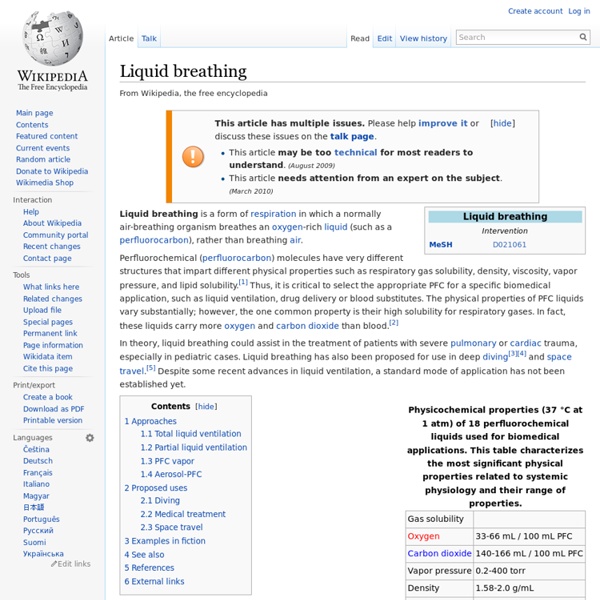Liquid breathing

Pitch drop experiment
The University of Queensland pitch drop experiment, featuring its then current custodian, Professor John Mainstone (taken in 1990, two years after the seventh drop and 10 years before the eighth drop fell). University of Queensland experiment[edit] The eighth drop fell on 28 November 2000, allowing experimenters to calculate that the pitch has a viscosity approximately 230 billion (2.3×1011) times that of water.[2] This is recorded in Guinness World Records as the world's longest continuously running laboratory experiment, and it is expected that there is enough pitch in the funnel to allow it to continue for at least another hundred years. The experiment was not originally carried out under any special controlled atmospheric conditions, meaning that the viscosity could vary throughout the year with fluctuations in temperature. Professor Mainstone subsequently commented: Professor John Mainstone died on 23 August 2013 following a stroke. Timeline[edit] See also[edit] References[edit]
The Pitch Drop Experiment | School of Mathematics and Physics
Pictures above: (1) Longtime custodian of the famous experiment, the late Professor John Mainstone. (2) Three webcams trained on the experiment 24/7. (3) The Pitch Drop Experiment. (4) Close up of the pitch drop. About the Pitch Drop Experiment While the School of Mathematics and Physics at The University of Queensland has an international reputation for cutting-edge research and innovative teaching in the disciplines of Mathematics, Physics and Statistics, it is also home to the famous Pitch Drop Experiment. The experiment is listed in the Guinness Book of World Records as the world's longest-running laboratory experiment. The first Professor of Physics at UQ, Professor Thomas Parnell, began an experiment in 1927 to illustrate that everyday materials can exhibit quite surprising properties. In 1927 Professor Parnell heated a sample of pitch and poured it into a glass funnel with a sealed stem. Live view of the Pitch Drop Experiment More information
Magnifying the Universe
Embed this infographic on your site! <iframe width="500" height="323" scrolling="no" src=" frameborder="0" allowfullscreen></iframe><br />Copyright 2012. <a href=" the Universe</a> by <a href=" Sleuth</a>. The above is an interactive infographic. We have also developed a complimentary poster that you can view here: Sizes of the Universe poster. Introduction: This interactive infographic from Number Sleuth accurately illustrates the scale of over 100 items within the observable universe ranging from galaxies to insects, nebulae and stars to molecules and atoms. While other sites have tried to magnify the universe, no one else has done so with real photographs and 3D renderings. How To Use: Step 1:To experience this interactive infographic in full screen (our recommendation) click the "Full Screen" button in the top right corner of the infographic. Credits:
Related:
Related:



